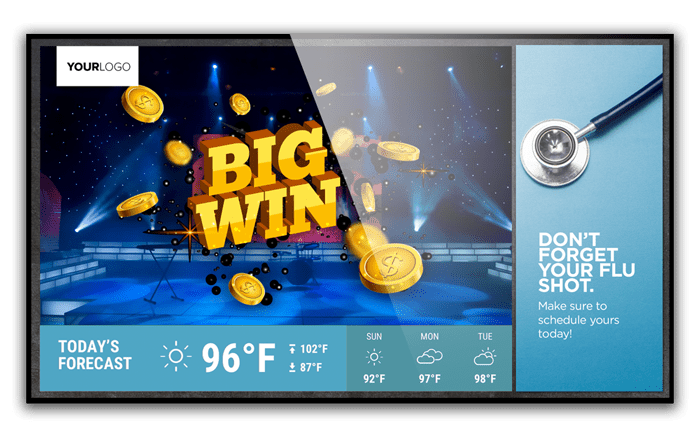How To Elevate The Patient Experience With Music
One of the biggest mistakes you can make in your patient experience is to think of your healthcare music as a mere commodity for keeping staff happy and filling the air in your waiting room.
Rather, music is an essential element of the patient experience, as it can effectively relieve patient anxiety, increase office efficiency, and motivate staff.
The power of music in healthcare is undeniable. To be clear though, your music isn’t going to be the sole determining factor in whether or not a patient feels relaxed and decides to return to your practice. Rather, music plays an invaluable role in contributing to an experience that makes your patients feel great, which in turn can help them want to return to your practice and spread the good word.
How does healthcare music contribute to that experience?
- By alleviating stress and anxiety
- By making patients feel more relaxed and welcomed
- By having the same positive influence on your staff, which
further empowers them to be more productive and provide
higher quality care
In this article we’ll discuss everything you need to know about sourcing and implementing an effective healthcare music solution that helps drive these types of results – and much more.
BEFORE SELECTING A HEALTHCARE MUSIC PROVIDER
#1: Understand Your Intended Experience.
Before you begin looking for a healthcare music solution, take the time to understand the type of experience you want to create at your practice and how you want your patients to feel. As a safe rule of thumb, you should always aim to create an experience that makes your patients feel welcomed and relaxed. By the same token, you also don’t want the atmosphere to feel synthetic and overly clinical. The programming you choose should support an experience that strikes this essential balance.
#2: Know Your Patients – And When They Visit.
It’s impossible to play music that each and every one of your patients loves, but you should have a clear understanding of who your patients are so that you can source programming that appeals to them. Consider any prevailing demographics within your patient base, and note what times of day your patient groups typically book appointments. Once you find a suitable healthcare music solution, you can schedule different programming throughout the day to meet their varying preferences.
For example, playing genres such as soft rock, oldies and jazz between 8 AM and 2 PM will help your senior patients feel more welcomed. In the late afternoon and early evening, you can switch to pop programming to provide a more familiar experience for young adults and teenage patients. This practice is a great example of dayparting, which is an essential strategy for engaging your patients on a deeper level.
#3: Understand Healthcare Music Technology.
Though business music technology isn’t very complex, the industry is filled with dozens of start-up music providers touting the latest and greatest. As such, it’s important that you have a basic understanding of the technology and what delivery options are available so that you can select the best provider and platform for your needs.

B) On-premise music solutions that leverage a commercial-grade, enterprise-level software platform and device to download music and store it on the device for present and future playback. The web-based software enables you to easily manage your music at a single location or across your entire network of locations.
Note: The term “streaming music” is often mistakenly used interchangeably to refer to options A and B. It’s important not to confuse the two, as they are functionally very different and come with varying advantages and disadvantages.
C) Internet-free methods, such as satellite and disc. These methods are ideal if you’re looking for a delivery medium that doesn’t rely on an internet connection. Keep in mind that these platforms must be managed and controlled at each location.
Finding The Best Delivery Option
While a device-free solution (Option A) may sound appealing, it’s important to remember that the playback reliability of a device-free solution is entirely dependent upon a) your internet connection, b) the strength and reliability of the provider’s feed and c) your own device, be it a computer, tablet or phone that’s connected to your sound system.
Note that some solutions are Bluetooth or Wi-Fi-enabled, requiring no physical connection to speakers, but that can be a frequent point of failure. Additionally, other devices and computers consuming bandwidth on your network can also affect playback quality.
We highly recommend utilizing option B if you want the most reliable playback and maximum control over your music – especially if you’re managing music for multiple locations. When music is streamed and stored to a media player, music will continue to play even in the event of an internet disruption. On the other hand, if your internet goes down while using a streaming solution that uses your own device, the music goes down with it.
The music can also stop if the provider’s feed breaks down, so if you do choose a lower-cost streaming-only solution that uses your personal device, it’s even more important to go with an experienced provider that has a quality feed and robust technology in place.
What About Option C?
Internet-free methods still exist, though they’re not offered by all providers. Many companies are moving away from satellite technology and physical media in favor of the sustainability and efficiency that internet-based options provide.
About Security And Internet-Based Music Delivery
Security and HIPAA compliance are always a consideration in the healthcare industry, but keep in mind that delivery methods that utilize your internet connection do not have any access to any data belonging to your organization or your patients. These platforms only pull media content from secure media servers, and not the other way around. Additionally, the servers don’t push content out to the players or personal devices.
We explore other important security considerations in #7.
What To Look For In An Experienced Healthcare Music Provider
Once you’ve developed a strong understanding of #1, #2 and #3, you should then find an experienced healthcare music provider that can help you achieve your goals in those areas. Other important qualities to look for in an experienced healthcare music provider include:
- Business-appropriate content
- Extensive music licensing capabilities
- Programming variety
- Secure, reliable and easy-to-use platforms
- Responsive service
- Value-added services (digital signage, sound masking, on-hold messaging)
Partnering with an experienced provider that has these capabilities is a must when it comes to the music for your practice. It’s also worth noting that these capabilities are not guaranteed with all companies. We’ll explore these factors below.

#4: Business-Appropriate Healthcare Music Content.
This point may seem like a given, but it’s worth emphasizing. While you may want to include music that resonates with younger patients and staff, you can’t afford to play content that isn’t fit for a family-friendly setting. Make sure the music you use comes from a professional background music provider that proactively filters their tracks for potential lyrics and subject matter that may be inappropriate for business use.
#5: Music Licensing.
Federal copyright law requires that music used in a commercial setting be licensed for business use. If you want to keep it legal, you can work directly with performing rights agencies to acquire licensing rights for your music. However, the most practical, affordable and efficient option is to work with a music provider that acquires those rights on your behalf.
Remember – using a consumer-based streaming app, your personal collection or a local radio station for music are practices that violate federal copyright laws, since these mediums aren’t licensed for use in a healthcare setting. You can learn more at https://us.moodmedia.com/sound/music-licensing/.
#6: Healthcare Music Programming Variety.
The provider you choose should offer a vast selection of professionally-designed, business-appropriate programs. They should also be able to help you select the right 5-10 programs that are fit for your practice, so that you can switch up the programming from time to time and keep the sound fresh for staff. Having access to a wide variety of programs is especially important if you have a regional network of hospitals and practices that serve a diverse patient base across several different communities.
Finally, make sure that the music provider you choose proactively updates their music programming at least once a month. Every day thousands of new tracks become available for commercial use, and your provider should be actively seeking out those songs and weaving them into your programming. By the same token, every song needs to be rested for a few weeks every now and then, and your provider should be removing those that have played in the rotation for a while.
#7: Simple And Secure Content Management.
If you go with delivery option B, then it’s vital to ensure that the content management system is secure and easy to use. The provider should use the latest encryption methods for content downloads and robust authentication technology for signing onto the software platform.
The platform should also be user-friendly and not require advanced tech skills, enabling your various users to quickly and easily manage, schedule and monitor your music.
Speaking of users, the right online CMS will also allow you to set varying levels of permission, so that you can a) have corporate users manage content for all locations, b) allow authorized staff to manage content for their respective location (if desired), or c) both. There should also be an option d), in which the provider manages and schedules the content on your behalf.
Always ask to see a demo of the content management system before you sign up for the solution. Additionally, you’ll also want to make sure that the provider offers responsive 24×7 telephone support and on-site service in the event that you need assistance.
#8: Responsive Service.
No two music providers are the same when it comes to service capabilities and scope. Make sure that the provider you choose offers 24×7 support and online troubleshooting so that you can quickly resolve any issues. If you have a regional footprint, make sure that your provider can offer installation and repair services at each and every one of your locations. There’s tremendous peace of mind in knowing that you can count on fast and reliable on-site support and installation no matter where you’re located.
#9: Value-Added Capabilities.
As important as music may be, it’s just one element of your entire patient experience. You can reduce costs, leverage economies of scale and further enhance the experience when you work with a provider that also offers solutions such as On-hold Messaging, Sound Masking, Digital Signage and Wayfinding, Scent and AV Systems.
Contact us today if you have any questions or want to learn more. Our experts will walk you through everything you need to know about creating a memorable patient experience that builds loyalty, motivates staff and boosts your bottom line.
CONNECT WITH US
Contact us today and elevate the customer experience at your business.
"*" indicates required fields
